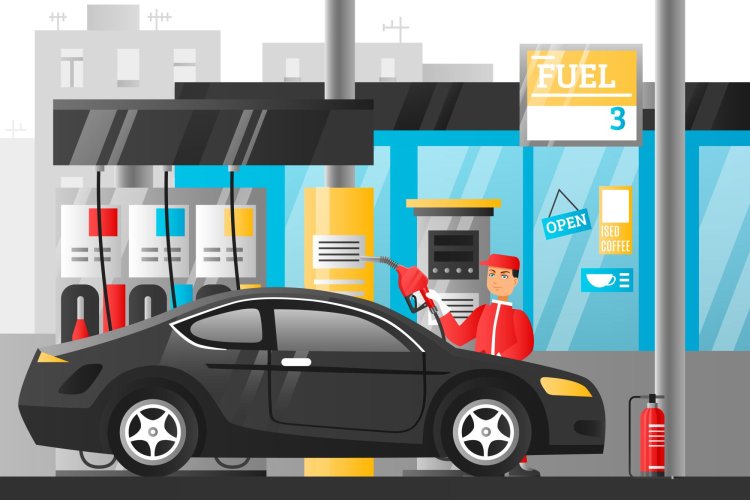Most drivers have a simple approach to refueling: when the tank gets low, pull into the nearest petrol station and fill up. It’s such a routine task that we rarely give it a second thought. After all, fuel is fuel, right?
Image = Designed by macrovector / Freepik
When you spot a massive petrol tanker at a station as you pull in, your mind might jump to Hollywood-style concerns about giant explosions or dramatic accidents. But according to automotive experts, the real risk from these industrial fuel deliveries is far more subtle – and much more likely to affect your car.
Kazimieras Urbonas, Supplier Excellence Manager at Ovoko, one of Europe’s largest online marketplaces for used car parts, has a stark warning for British motorists: never fill up your car when a petrol tanker is making a delivery at the station.
“The fuel delivery process creates turbulence that stirs up sediment, rust, and water from the bottom of storage tanks,” explains Urbonas. “Fill up during or immediately after delivery, and you’re essentially pumping debris straight into your engine.”
This seemingly harmless timing mistake could contaminate your fuel and lead to expensive engine damage, Urbonas is warning. Here, he explains why this everyday scenario represents a hidden danger that most drivers never consider.
What Happens During A Fuel Delivery
When a tanker arrives at a petrol station, it’s not simply topping up the tanks. The delivery process involves pumping thousands of litres of fuel at high pressure through large hoses, creating significant turbulence within the underground storage tanks.
“Think of it like stirring up a pond that’s been sitting still,” says Urbonas. “All the debris that’s settled at the bottom suddenly gets mixed back into the fuel that will eventually reach your car’s engine.”
This debris is more than just harmless dirt. Over months and years, underground fuel tanks accumulate rust particles from aging infrastructure, water from condensation and small leaks, and sediment that separates from the fuel itself. During normal operation, these contaminants settle safely at the bottom of the tank, well below the fuel pumps.
But during delivery, the force of incoming fuel can lift this cocktail of harmful substances back into suspension, where it becomes available to be pumped directly into unsuspecting vehicles.
The Contamination Risk To Your Vehicle
Modern fuel systems are designed with filters and safeguards, but they weren’t built to handle large amounts of debris in one go. When contaminated fuel enters your tank, several components become vulnerable.
Fuel injectors, which spray precise amounts of fuel into your engine’s cylinders, can become clogged with particles as small as 10 microns. Your fuel filter, designed to catch occasional impurities, can become overwhelmed and allow contaminants to pass through to sensitive engine components.
“We do see a steady stream of pumps, injectors and sensors that fail because some form of contaminated or degraded fuel got into the system, whether that’s water from an ageing storage tank, particulate sludge stirred up during deliveries, or fuel that’s gone bad in a car’s own tank,” explains Urbonas. “Damaged fuel pumps, clogged injectors, and failed sensors all trace back to poor-quality fuel entering the system.”
Water contamination presents its own problems, potentially causing corrosion in fuel lines and creating the perfect environment for bacterial growth that can further degrade fuel quality.
4 Warning Signs Of Fuel Contamination
If you’ve recently filled up and notice any of these symptoms, Urbonas says contaminated fuel could be the culprit:
- Rough Idling: Your engine struggles to maintain a steady idle, with noticeable vibrations or irregular rhythm when stationary.
- Engine Stutter Or Hesitation: Particularly noticeable during acceleration, your engine may hesitate, jerk, or feel like it’s not getting enough fuel.
- Dashboard Warning Lights: Check engine lights or fuel system warnings may illuminate as sensors detect irregular fuel flow or combustion.
- Reduced Fuel Economy: Contaminated fuel burns less efficiently, meaning you’ll find yourself visiting petrol stations more frequently than usual.
“These symptoms can appear within hours of filling up with contaminated fuel,” warns Urbonas. “The sooner you address the issue, the less likely you are to face expensive repairs.”
Expert Recommendations For Safe Refuelling
The solution is surprisingly simple: timing. Urbonas recommends waiting at least 30 to after a tanker delivery before filling your tank. This allows time for stirred-up sediment to resettle at the bottom of the storage tanks.
If you arrive at a station during or immediately after a delivery, simply drive to another location. Most areas have multiple petrol stations within a short distance, making this an easy precaution to take.
For regular refuelling, choose stations with high turnover rates. Busy stations receive more frequent deliveries, meaning their fuel is fresher and has less time to accumulate problematic sediment.
“Quality fuel stations also invest in better filtration systems and regular tank maintenance,” adds Urbonas. “Building a relationship with reliable stations pays off in the long run.”
Kazimieras Urbonas, Supplier Excellence Manager at Ovoko, commented:
“Modern engines are far more sensitive to fuel quality than drivers might realise. Where older vehicles might have powered through with slightly contaminated fuel, today’s precision-engineered systems can be seriously damaged by particles that are virtually invisible to the naked eye. We’re talking about fuel injectors calibrated to tolerances measured in microns, so any debris can throw these systems off-balance.
In my role ensuring quality across automotive supply chains, I’ve seen how even small contamination issues can cascade into major component failures. A clogged fuel injector might seem like a minor inconvenience, but it can lead to uneven combustion, damaged catalytic converters, and ultimately engine problems that cost thousands to repair.
The frustrating part is how easily preventable this is. Simply avoiding fuel stations during delivery times, or waiting an hour after you see a tanker leave, can save you from headaches and hefty repair bills. It’s one of those small precautions that makes a massive difference to your vehicle’s longevity and performance.”


